|
|
ARTHROPODS:
Insects»
Spiders»
Centipedes»
Millipedes»
Sowbugs»
Harvestmen»
Mites
& Ticks»
Scorpions»
Identification
Tips»
About
the Critter Files»
Links» |
|
|
|
 |
FLOWER
FLIES
Including
HOVER FLIES & DRONE FLIES
Critter
Files/Insects/True
Flies/Flower Flies
By Blake Newton
University of Kentucky Department of Entomology |
| |
|
| Common
Kentucky Flower Flies: |
| |
| TAXONOMY |
KINGDOM:
Animalia | PHYLUM: Arthropoda | CLASS: Insecta | ORDER :Diptera
| FAMILY: Syrphidae (flower flies, hover flies, drone flies) |
| |
| Other
Names: Hover Flies, Drone Flies, Syrphids |
| |
WHAT
IS A FLOWER FLY?
LIFE CYCLE
ECOLOGY
PEST STATUS
COMMON KENTUCKY FLOWER FLIES
COLLECTING & PHOTOGRAPHY
FLOWER FLY FACTS
MYTHS, LEGENDS, AND FOLKLORE |
| |
| WHAT
IS A FLOWER FLY? |
|
| Flower flies,
many of which are called "hover flies," belong to the family
Syrphidae in the order Diptera (true flies). The most commonly
seen species of flower flies are brightly colored, bee-like flies
with yellow and black markings. Although flower flies resemble
bees, they can be distinguished by their wings: flower flies (like
all flies) have only 2 wings. Bees have 4 wings.
Flower flies are not as easy to distinguish from other kinds of
flies. Many kinds of flies, especially soldier flies and bee
flies, also have a bee- or wasp-like appearance. The best
way to accurately identify a flower fly is by inspecting the wings
with a microscope. All common flies in the family Syrphidae
have a so-called "spurious vein" in each wing (shown below).
It is called a "spurious vein" because neither end
connects with other wing veins. Most veins in insect wings are connected
at either end to other veins.
|
| |
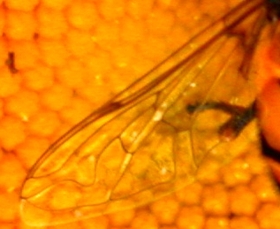 Above:
Wing of a flower fly. Roll over the picture
Above:
Wing of a flower fly. Roll over the picture
with your mouse to highlight the vein. (B. Newton, 2003) |
| |
Immature
flower flies are legless and wormlike, and, like most fly larvae,
are very difficult to identify, even for experts. They are seldom
encountered.
|
|
| SIZE:
Adult body length up to 5/8", larvae up to 4/8" |
| |
| LIFE
CYCLE |
|
Like
all flies, flower flies have complete metamorphosis with egg, larval,
pupal, and adult stages. The larvae are legless and wormlike.
Winged adults are active during warm months. Most species
overwinter as pupae in soil or under fallen leaves. |
| |
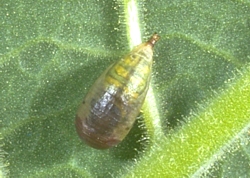 Flower
fly pupa (R. Bessin, 2000)
Flower
fly pupa (R. Bessin, 2000) |
| |
| ECOLOGY |
|
| Flower flies live in many
habitats, but the most common species are found in field crops, gardens,
and weedy areas (such as fence rows). The adult flies often visit
flowers to feed on nectar, which makes them an easy meal for predators
like crab spiders and
ambush bugs.
|
| |
| Flower fly larvae are
also found in a variety of habitats. Some live and feed in decaying
plant material. Some are fully aquatic and are found in septic
water. Several common species live on plants where they hunt
for aphids and other small insects. |
| |
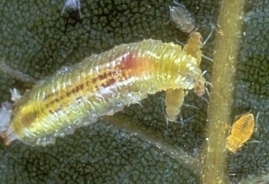 Predatory
flower fly larva feeding on aphids. (Image courtesy University of
Florida)
Predatory
flower fly larva feeding on aphids. (Image courtesy University of
Florida) |
| |
| PEST
STATUS |
|
Most flower
flies are not considered pests. The species that resemble
bees are not able to sting or bite, although sometimes they will
land on humans to gather moisture in the form of sweat droplets.
Many species of flower flies are considered beneficial because
their larvae feed on aphids and other pests.
The larvae of a few species
of drone flies, called "rat-tailed maggots," are occasional
pests in livestock operations. Some drone fly larvae have
also been known to cause intestinal myiasis in humans, but this
is very rare in the United States.
Read more about rat-tailed
maggots in our online ENTFact:
www.uky.edu/Agriculture/Entomology/entfacts/livestc/ef500.htm
|
| |
| COMMON
KENTUCKY ROBBER FLIES |
|
|
HOVER
FLIES
GENUS: Metasyrphus,
others
Most of the flower flies
that live in Kentucky are commonly called "Hover Flies."
These flies are able to hover in mid-air, much like hummingbirds.
There are many species of hover flies in Kentucky. Many of
them resemble bees and wasps and are found in weedy habitats and
gardens. Small black and yellow hover flies are very common
around homes. The larvae of several flower fly species are
predators of aphids and other small insects (one is pictured in
the Ecology section above). |
| |
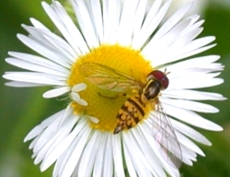 Hover
Fly (B. Newton, 2003)
Hover
Fly (B. Newton, 2003) |
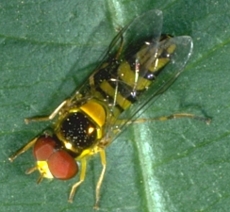 Hover
Fly (R. Bessin, 2000)
Hover
Fly (R. Bessin, 2000) |
| |
|
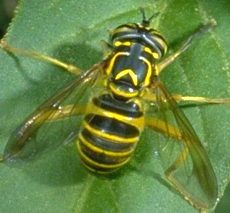 Hover
Fly (R. Bessin, 2000)
Hover
Fly (R. Bessin, 2000) |
|
|
|
DRONE
FLIES
GENUS: Eristalis
Certain
large yellow and black flower fly species in the genus Eristalis, like the one pictured below,
are called "Drone Flies". Drone flies are usually
over 1/2" long. Although drone fly adults are often found
on flowers, larval drone flies, called "rattailed maggots,"
live in polluted water. A rattailed maggot is so-called because
it has a long breathing tube on the end of the abdomen which resembles
a tail. The tube is extended above the water surface, allowing
the maggot to breath in oxygen-poor water. |
| |
 Drone
fly (B. Newton, 2003)
Drone
fly (B. Newton, 2003) |
|
| |
| COLLECTING
& PHOTOGRAPHY |
|
Flower flies are easy
to find during the summer in Kentucky. Look for them in gardens
and in weedy areas, or anyplace else where wild or cultivated flowers
grow. Flower flies are able to hover in place and are accurate
fliers, so it is sometimes a challenge to capture one with a sweep
net. They will often remain still on a flower for a few moments,
though, creating a good opportunity for a photograph.
Larval flower flies and
rattailed maggots can be more difficult to find. Look for
predatory syrphid larvae on certain crop plants (like tobacco) that
are frequented by aphid pests. Rattailed maggots are fairly
common in silage ponds and other polluted water sources, but these
areas are not a safe place to collect insects.
|
| |
| MYTHS
- LEGENDS - FOLKLORE |
|
Flower flies are often
called "sweat bees" because of their resemblance to bees
and because they often land on human skin to gather sweat. Flower
flies cannot sting, but there are small black bees in the family
Halictidae (also commonly called sweat bees) that will occasionally
sting humans while they are gathering sweat. Often, the innocent
flower fly is been blamed for some of the stings caused by "true"
sweat bees. |
| |
Original document: 25 May 2004
Last updated: 25 May 2004
Photos courtesy R.
Bessin and B. Newton, University of Kentucky, except Syrphid Larva w/Aphids,
University of Florida; used with permission
The Kentucky Critter
Files are maintained by Blake Newton, Department of Entomology, University
of Kentucky.
Contact: blaken@uky.edu
|

